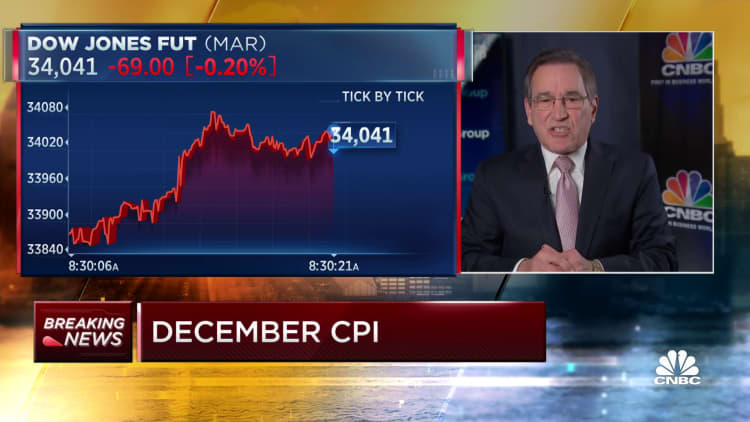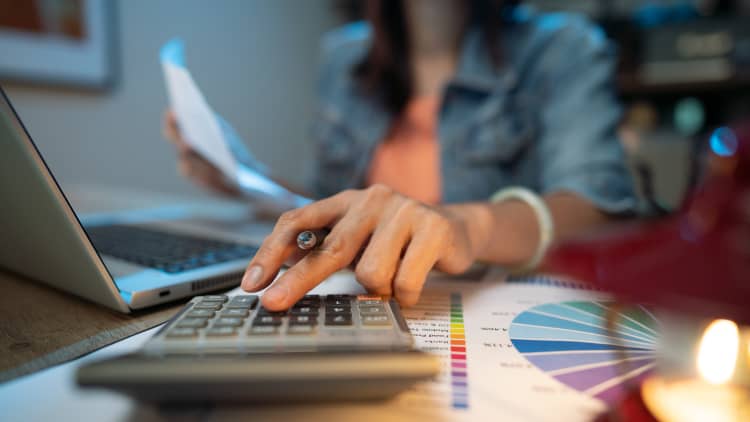The inflation rate declined in December as consumers saw prices plummet at the gasoline pump, providing another hopeful sign for households that price pressures are continuing to ease from their highest level in decades.
Inflation closed out 2022 with a 6.5% annual reading, as measured by the consumer price index, the U.S. Bureau of Labor Statistics said Thursday. It was in line with economists' expectations.
The CPI reading for December marked the smallest 12-month increase since October 2021. It fell from 7.1% in November.
The index measures how quickly average prices are rising or falling for a basket of goods and services, such as consumer electronics, food, utilities and tickets to sporting events.
A decline in the annual inflation rate doesn't mean consumers saw deflation, which is when overall prices decrease. The annual rate in December was still positive. The decline in the annual inflation rate means that prices rose at a slower pace than earlier in the year.
Monthly price movements are a better gauge of short-term inflation trends than the annual rate. Significantly, the monthly inflation reading was negative — declining by 0.1% — meaning average prices did fall for American consumers in December relative to November. The last time that happened was May 2020, when consumer demand collapsed in the early months of the Covid pandemic.
More from Personal Finance:
Americans lean more on credit cards as expenses stay high
3 money moves you should make at the start of the year
2022 was the worst-ever year for U.S. bonds
"Inflation is on its back heels," said Mark Zandi, chief economist at Moody's Analytics. "It's moderating steadily and, at this point, quickly."
"I don't think people will be talking about inflation this time next year," Zandi added. "It just won't be at the top of their agenda when thinking about their own finances."
Categories with the largest changes in December

While on the decline, the annual inflation rate remains at its highest since the early 1980s. Pandemic-era inflation peaked at 9.1% in June 2022.
Items among those with the most rapid price growth in 2022 included food at elementary and secondary schools (prices jumped 305%), eggs (59.9%), margarine (43.8%), fuel oil (41.5%) and airline fares (28.5%).
Some of these prices ballooned for reasons beyond broad pandemic-era inflationary factors such as snarled supply chains, pent-up consumer demand, household cash infusions, labor shortages and war in Ukraine.
For example, the U.S. suffered its deadliest bird-flu outbreak in history last year, causing the death of millions of hens and pushing up egg prices dramatically. Global weather events and export bans in major vegetable-oil producers such as Indonesia, Canada and Brazil contributed to fast-rising margarine prices. Federal pandemic-era waivers for free school lunches, the root cause of the increase in food at schools, expired last year.
On the opposite end of the spectrum, some items had negative inflation rates in 2022. Those with the largest annual price declines included consumer electronics such as smartphones and TVs, for which prices fell by 22.2% and 14.4% in 2022, respectively. Car and truck rental prices fell by 4.9%, while beef and veal prices fell by 3.1%, women's dresses by 2.3% and admission to sporting events by 1.5%.
A decline in the inflation rate for electronics may seem counterintuitive when iPhones and other gadgets didn't necessarily come with steep discounts in 2022. In fact, that "decline" on paper is due to how the federal government accounts for improvements in product quality over time.
The huge amount of inflation we had from rising gas prices has now almost completely reversed.Andrew Huntersenior U.S. economist at Capital Economics
On a monthly basis, other categories saw big swings from November to December.
A monthly 9.4% decrease in gasoline prices was "by far the largest contributor" to overall deflation in December, according to the CPI report. Average gas prices fell to $3.09 a gallon on Dec. 26, from $3.53 a month earlier, according to weekly data published by the Energy Information Administration.
That's largely a function of lower global prices for crude oil, which is refined into gasoline. Oil prices — which shot up in the first half of 2022 amid a supply shock due to Russia's invasion of Ukraine — have broadly declined amid fear of potential recession and uncertainty about future energy demand, said Andrew Hunter, senior U.S. economist at Capital Economics.
"The huge amount of inflation we had from rising gas prices has now almost completely reversed," Hunter said.
Other categories with declines over the month of December included used cars and trucks (a 2.5% decrease), airline fares (3.1%), and new vehicles and personal care, which each fell by 0.1%, according to the CPI report.
Notably, the shelter index increased over the month, with prices swelling by 0.8%, up from 0.6%. But signals indicate housing costs have peaked and should start moderating "meaningfully" in CPI data by the summer and into the second half of the year, Zandi said.
Why inflation has been so high
If inflation were to continue to moderate, it would be a welcome reprieve for households. The average person has lost purchasing power, since their wages have grown at a slower pace than prices for the things they buy.
Hourly wages have fallen by 1.7% in the past year, after accounting for inflation, according to the U.S. Department of Labor.
The typical household needs to spend $371 more per month to buy the same goods and services they did last year, according to a Moody's analysis of the annual inflation rate in December.
A healthy economy experiences a small degree of inflation each year. U.S. Federal Reserve officials aim to keep inflation around 2% annually. But prices started rising at an unusually fast pace starting in early 2021, following years of low inflation.
As the U.S. economy reopened, a supply-demand imbalance fueled inflation that was initially limited to items such as used cars, but which has since spread and lingered longer than many officials and economists had expected.
The problem isn't siloed in the U.S., though. By the first quarter of 2022, average annual inflation rates had at least doubled from their pre-pandemic level in 37 out of 44 developed nations in the Organization for Economic Cooperation and Development, according to the Pew Research Center.
On the global stage, inflation first showed up in the U.S., however. That's partly due to Covid-related restrictions unwinding sooner in many states relative to the rest of the world and federal support for households kickstarting the economic recovery.
Americans had more disposable income as the economy reopened, the result of federal funds such as stimulus checks and pent-up demand from staying at home. Covid-19 lockdowns snarled global supply chains — meaning ample cash ran headlong into fewer goods to buy, driving up prices. War in Ukraine caused a spike in global energy costs, generally feeding into rising costs to produce and distribute goods.
The dynamics that had underpinned high inflation for physical goods seem to be retreating. Supply-chain issues have largely faded, while a strong U.S. dollar relative to foreign currencies generally makes it less costly to import goods from overseas.
But inflation for "services" — which might include anything from haircuts to hotel stays — has proven a bit stickier. Labor costs are a big driver. Demand for workers is near historic highs and the unemployment rate is low, helping fuel competition for workers and therefore fast-rising wages. This creates high labor costs for businesses and puts upward pressure on their service costs.
Economists generally prefer using a so-called "core" inflation measure to gauge inflationary trends in the U.S. economy. This measure of CPI assesses prices without food and energy (such as gasoline and fuel oil), which can experience big swings up and down from month to month.

The monthly inflation excluding food and energy was 0.3% in December, up slightly from 0.2% in November. Shelter was the "dominant" factor in that increase, according to the CPI report.
Housing costs are a major component of core inflation and account for the largest portion of average household budgets. The government's measure of housing inflation is slow-moving, Hunter said. Private-sector data shows rental growth is slowing "very sharply," a trend that should show up in the CPI over the coming months, Hunter said.
Aside from housing, "it just feels like, across the board, inflation is cooling off here very quickly," Zandi said. "I think it's already starting to feel better for people."


